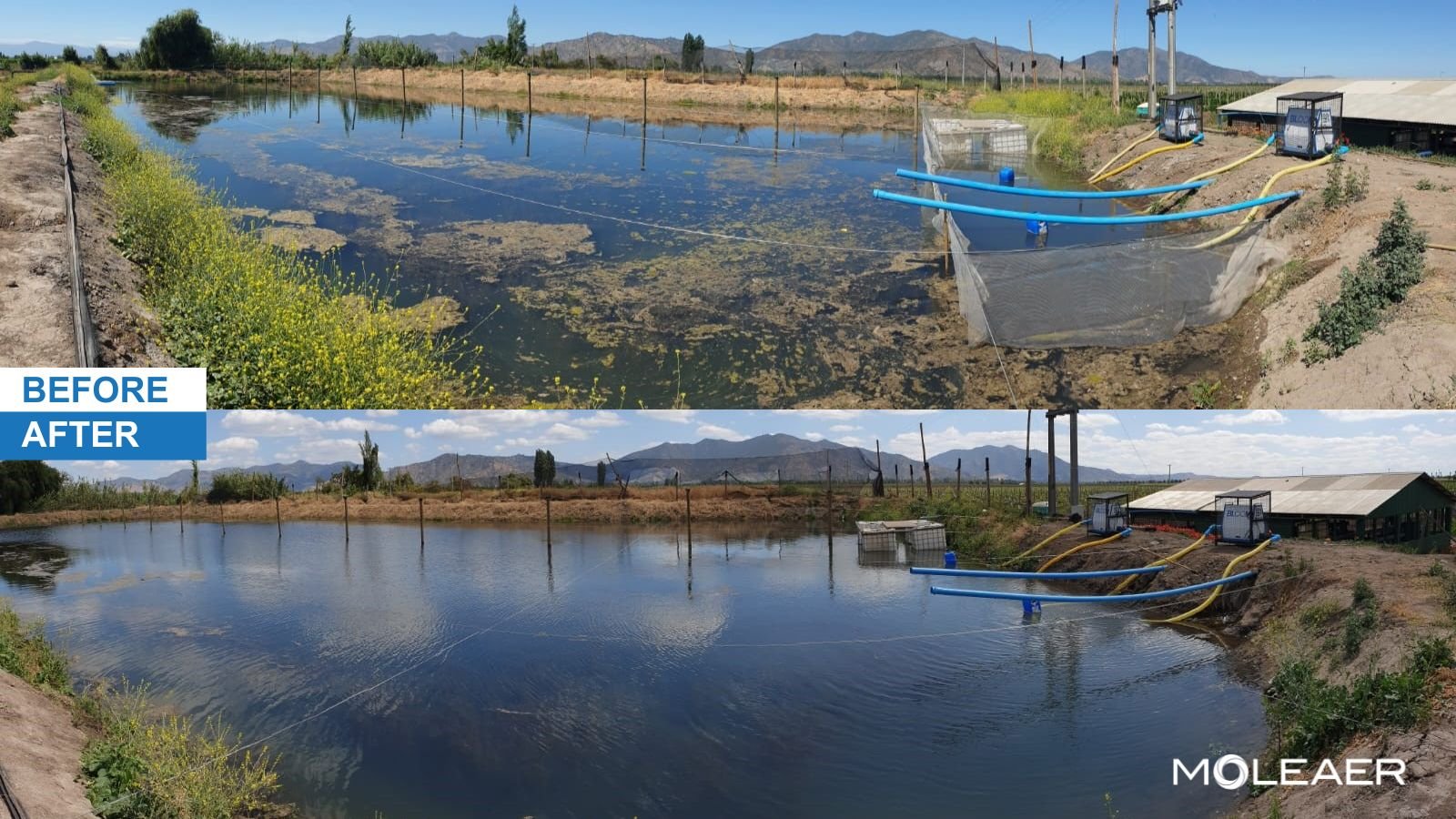An avocado grower in Chile, with support from Moleaer’s distributor, Kapicua, saw better shoot growth and root mass in year one and increased yield and better quality fruit in year two after deploying Moleaer’s nanobubble technology in their irrigation reservoir. Increased fruit yield and better fruit quality lead to an increase in ROI for the grower.
High-quality irrigation water is important for healthy root and plant development to produce quality crops, though it can be challenging to maintain water quality in irrigation reservoirs. Over time and depending on temperatures, dissolved oxygen (DO) levels decline, negatively impacting plant health from anoxic soil conditions that promote pathogens like Phytophthora. Also, algae blooms and muck increase, leading to poor water quality in reservoirs.
Growers seek sustainable ways to maintain reservoir health while promoting healthy plants and crops. Nanobubble technology provides a chemical-free and sustainable solution that treats common reservoir problems with benefits that can be seen at the crop level.
Nanobubble technology transfers gas in two forms, dissolved and nanobubbles. Moleaer’s nanobubble generators transfer gas at over 85% efficiency, significantly increasing dissolved oxygen levels in irrigation water to improve water quality and reduce algae and muck. These high levels of DO also support healthy root and plant development through improved nutrient uptake efficiency and reduced disease pressure.
Additionally, these generators produce nanobubbles which are 2500 times smaller than a grain of salt and have additional benefits. Nanobubbles enhance soil structure and function, improving the distribution of high-quality water to the root zone. Through natural oxidation, nanobubbles also reduce bacteria and other contaminants in the water, reducing water-borne pathogens.
Through better water quality and the power of nanobubbles, growers see better root development, healthier and more resilient crops, and ultimately improved yields.

Kapicua did a two-year trial on a Hass avocado orchard where they compared trees irrigated with and without oxygen nanobubbles. They took 20 random samples during and after each season and measured average plant height and width, number of plants in production, average fruit per plant, and fruit diameter.
In October 2020, two Moleaer Bloom nanobubble generators with a flow rate of 150 GPM (34 m3/hr) each were installed on the reservoir. These were later replaced in 2021 by one of Moleaer’s 1000 GPM (227 m3/hr) Nexus nanobubble generators with an external liquid oxygen gas source. Water was pumped from the irrigation reservoir to the orchard.
During the first year, the grower saw reduced algae growth, starting 45 days after installation and fully controlled by the fourth month. They used carp fish to control the aquatic plants as well. The images show the before and after nanobubble treatment.

Additionally, in the first season, there was a significant impact on shoot growth and root mass for plants irrigated with nanobubble-enriched water. The avocado trees had better plant vigor due to the improved root zone conditions and increased nutrient and water absorption.
At the end of the second season, the trees irrigated from the nanobubble-enriched reservoir had better development seen by a 20% increase in tree height and a 30% increase in tree width. The number of trees with fruit increased by 40% and they saw an almost 200% greater crop load per tree compared to trees not irrigated with nanobubble-enriched water.
“This effect on vigor - due to better roots condition and therefore a better absorption of nutrients and water - directly impacts the condition of the trees and, consequently,
the number of fruits per plant while maintaining good quality and size. In the treatment with nanobubbles, a 193% increase in the number of fruits per plant was seen compared with the treatment without nanobubbles.
“In addition, a greater precocity in the cultivation was seen, increasing the quantity and quality of the first harvests and increasing the profitability of the orchard,” says Benjamin Labbé, Business Manager of Moleaer LATAM.

In terms of costs, the grower needed fewer chemical applications to control algae and irrigation clogging. This allowed a savings of $40 USD per hectare per application (usually around 2-8 per season) of phosphoric acid, totaling $80 to $320 USD per hectare, and additional savings of $7,000 USD per reservoir per year by reducing copper sulfate treatments. The irrigation system needed fewer backwash cycles, thanks to better water quality.
At the soil level, better oxygenation improved the balance of microorganisms and increased infiltration and drainage, which is critical to maintaining root vitality. Based on the results of this trial, the producer’s ROI increased by $8,290 USD per hectare. The benefits of using oxygen nanobubble technology saved on costs, simplified operations and improved the farmer’s profitability.
Download Now